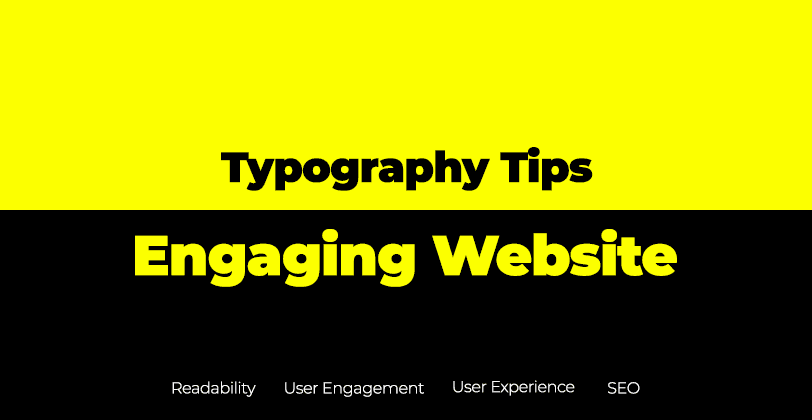10 Tips on Typography in Web Design
Typography is a cornerstone of web design, significantly influencing user experience, readability, and brand perception. In this guide, we’ll explore 10 actionable tips to master typography in web design, blending expert insights, real-world examples, and SEO optimization to elevate your website. By the end of this guide, you'll have a clear understanding of how to use typography to improve both functionality and aesthetics in your designs.
Typography in Web Design is more than just choosing pretty fonts. It directly impacts how users interact with your content, whether they find your website engaging, and whether they trust your brand. Proper typography not only ensures that your message is clear but also plays a significant role in creating an emotional connection with your audience.
Understanding Typography Basics
Typography forms the visual language of your website, encompassing font styles, sizes, and arrangements. Getting the basics right sets the foundation for effective web design.
Key Components of Typography:
Typeface vs. Font: A typeface is a family of related fonts (e.g., Helvetica), while a font refers to a specific weight and style within a typeface (e.g., Helvetica Bold).
Line Length: Maintain an optimal line length of 50-75 characters for body text to ensure readability.
Kerning, Tracking, and Leading: These elements influence spacing between characters, words, and lines, respectively, ensuring balance and clarity.
Practical Tips:
Stick to 2-3 font styles per design.
Use a style guide to standardize typography across your site.
Avoid decorative fonts for body text as they can compromise readability.
Key Takeaways:
Typography basics are the building blocks of effective design. Mastering these principles ensures that your site’s content is not just visually appealing but also easy to consume.
Choosing the Right Font Pairings
Harmonious font pairings enhance visual appeal and guide user focus. A well-thought-out pairing can help communicate your brand’s personality while ensuring readability.
Techniques for Effective Pairing:
Contrast: Combine fonts with contrasting weights or styles to create visual interest. For example, pairing a bold headline font with a sleek body font creates hierarchy and focus.
Harmony: Fonts with similar x-heights or proportions often work well together. This ensures your typography looks cohesive.
Tools: Google Fonts and Font Pair are great tools for exploring compatible typefaces.
Examples of Font Pairings:
Roboto (Sans-Serif) + Merriweather (Serif)
Open Sans (Sans-Serif) + Lora (Serif)
Common Pitfalls:
Avoid pairing fonts that clash stylistically, such as mixing highly ornate fonts with modern sans-serif styles.
Limit the use of decorative fonts to headlines or call-to-action elements.
Pro Tip:
Test font pairings with actual content, as the context can influence how they look together.
Ensuring Readability Across Devices
Responsive typography ensures that your website looks great and functions well on screens of all sizes. With mobile-first design becoming the standard, readability across devices is non-negotiable.
Best Practices for Responsive Typography:
Relative Units: Use
emorreminstead of fixed units likepxfor scalability.Viewport-Based Typography: Implement CSS techniques like
clamp()to create responsive font sizes. For example:
Media Queries: Adjust font sizes, line heights, and spacing based on screen size to enhance legibility.
Stat:
88% of users are less likely to return to a website after a bad user experience (Source: Toptal).
Leveraging White Space Effectively
White space, or negative space, is the unsung hero of good web design. It gives your content room to breathe and helps users focus on what’s important.
How to Use White Space:
Line Height: Maintain a line height of 1.5 for body text to enhance readability.
Padding and Margins: Add sufficient space around text blocks and visual elements.
Break Up Text: Use white space to separate sections and guide users through your content.
Stat:
Websites that effectively use white space have a 20% higher engagement rate (Source: NNGroup).
Example:
Compare a cluttered homepage to one with ample white space. Which one feels more professional and easier to navigate?
Optimizing Typography for SEO
Typography impacts SEO by influencing user engagement metrics like bounce rate, dwell time, and click-through rates. Search engines reward user-friendly websites, so optimizing your typography indirectly boosts your rankings.
Tips for SEO-Friendly Typography:
Keyword Placement: Use primary and secondary keywords naturally in headers and body text.
Headings: Use proper heading hierarchy (H1 for titles, H2 for subsections, etc.).
Alt Text for Images: Describe text-based visuals with relevant keywords.
Schema Markup:
Add schema for "FAQPage" or "HowTo" to enhance visibility in search results.
The Role of Hierarchy in Typography
Visual hierarchy ensures that users can quickly scan and navigate your content. Typography plays a crucial role in creating this structure.
Techniques for Establishing Hierarchy:
Font Size: Use larger fonts for headlines and smaller fonts for body text.
Font Weight: Bold or semi-bold styles emphasize important information.
Color: Use contrasting colors to differentiate elements.
Example:
Consider an e-commerce homepage: the product categories (headlines) are large and bold, while descriptions are smaller and lighter in weight.
Using Custom Fonts and Licensing
Custom fonts add uniqueness to your website but come with considerations like licensing and performance.
Key Considerations:
Licensing: Always review font licensing agreements to avoid legal issues.
Performance: Host fonts locally or use a CDN to reduce load times.
Tools:
Use Font Squirrel for free, web-safe fonts.
Subset font files to include only the characters you need.
Accessibility Best Practices in Typography
Accessible typography ensures that everyone, including users with visual impairments, can engage with your content.
Guidelines:
Contrast Ratio: Maintain a minimum contrast ratio of 4.5:1 for normal text and 3:1 for large text.
Font Size: Provide resizable text options via browser settings or in-app controls.
Readable Fonts: Avoid overly decorative or script fonts for essential content.
Pro Tip:
Use tools like WebAIM’s Contrast Checker to test your typography’s accessibility.
Testing and Refining Typography Choices
Even the best typography needs testing and refinement to ensure it meets user needs.
Tools for Testing:
A/B Testing: Tools like Google Optimize let you test different font styles and sizes.
Heatmaps: Tools like Hotjar show where users’ attention is focused, helping refine typography placement.
Metrics to Monitor:
Bounce rate
Time on page
Conversion rates
Expert Insights
We spoke with Ash, a leading web designer, who emphasized:
On Readability: "Typography should always prioritize clarity over creativity. A user-friendly design is a successful design."
On Trends: "Variable fonts are revolutionizing responsive design, allowing designers to create flexible, adaptive typography."
FAQ
What is the ideal font size for web design?
A minimum of 16px for body text is recommended to ensure readability.
How do I choose the right font for my brand?
Consider your brand’s personality, target audience, and test multiple fonts to find the perfect fit.
Are custom fonts better than standard fonts?
Custom fonts enhance uniqueness but must be optimized for performance and licensed properly.
Conclusion
Typography in web design is more than aesthetics; it’s about creating a seamless, engaging user experience. By following these 10 tips, you can craft a visually appealing, accessible, and SEO-optimized website. Start experimenting today to see the transformative impact of effective typography. Remember, great typography not only improves readability but also establishes a strong visual hierarchy and reinforces your brand identity.

Brad
Author
Comments




